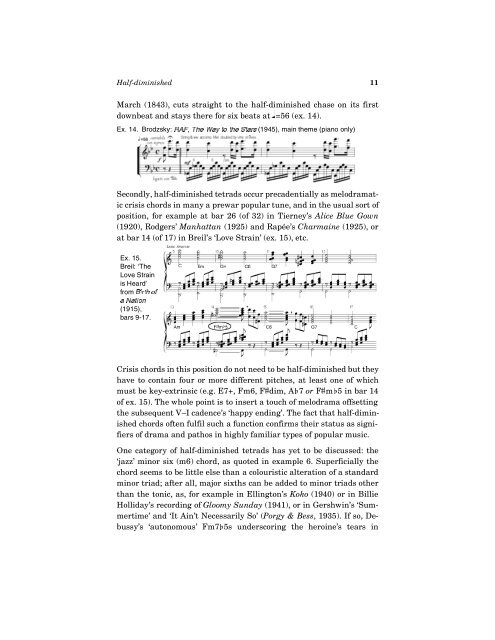Create successful ePaper yourself
Turn your PDF publications into a flip-book with our unique Google optimized e-Paper software.
Half-diminished 11<br />
March (1843), cuts straight to the half-diminished chase on its first<br />
downbeat and stays there for six beats at q=56 (ex. 14).<br />
Ex. 14. Brodzsky: RAF, The Way to the Stars (1945), main theme (piano only)<br />
Secondly, half-diminished tetrads occur precadentially as melodramatic<br />
crisis chords in many a prewar popular tune, and in the usual sort of<br />
position, for example at bar 26 (of 32) in Tierney’s Alice Blue Gown<br />
(1920), Rodgers’ Manhattan (1925) and Rapée’s Charmaine (1925), or<br />
at bar 14 (of 17) in Breil’s ‘Love Strain’ (ex. 15), etc.<br />
Ex. 15.<br />
Breil: ‘The<br />
Love Strain<br />
is Heard’<br />
from Birth of<br />
a Nation<br />
(1915),<br />
bars 9-17.<br />
Crisis chords in this position do not need to be half-diminished but they<br />
have to contain four or more different pitches, at least one of which<br />
must be key-extrinsic (e.g. E7+, Fm6, F#dim, A$7 or F#m$5 in bar 14<br />
of ex. 15). The whole point is to insert a touch of melodrama offsetting<br />
the subsequent V–I cadence’s ‘happy ending’. The fact that half-diminished<br />
chords often fulfil such a function confirms their status as signifiers<br />
of drama and pathos in highly familiar types of popular music.<br />
One category of half-diminished tetrads has yet to be discussed: the<br />
‘jazz’ minor six (m6) chord, as quoted in example 6. Superficially the<br />
chord seems to be little else than a colouristic alteration of a standard<br />
minor triad; after all, major sixths can be added to minor triads other<br />
than the tonic, as, for example in Ellington’s Koko (1940) or in Billie<br />
Holliday’s recording of Gloomy Sunday (1941), or in Gershwin’s ‘Summertime’<br />
and ‘It Ain’t Necessarily So’ (Porgy & Bess, 1935). If so, Debussy’s<br />
‘autonomous’ Fm7$5s underscoring the heroine’s tears in














